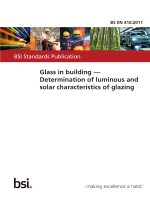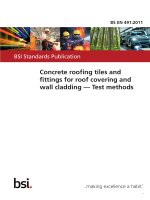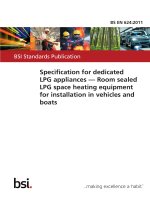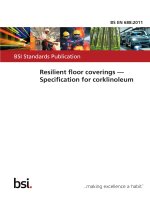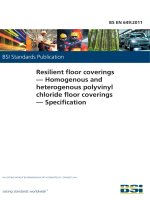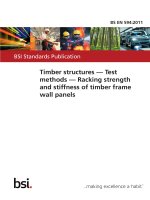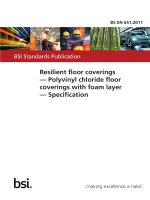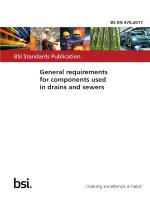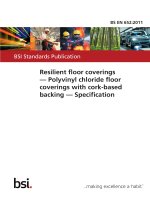Bsi bs en 62359 2011
Bạn đang xem bản rút gọn của tài liệu. Xem và tải ngay bản đầy đủ của tài liệu tại đây (2.05 MB, 70 trang )
BS EN 62359:2011
BSI Standards Publication
Ultrasonics — Field
characterization — Test
methods for the determination
of thermal and mechanical
indices related to medical
diagnostic ultrasonic fields
NO COPYING WITHOUT BSI PERMISSION EXCEPT AS PERMITTED BY COPYRIGHT LAW
raising standards worldwide™
BRITISH STANDARD
BS EN 62359:2011
National foreword
This British Standard is the UK implementation of EN 62359:2011. It is
identical to IEC 62359:2010. It supersedes BS EN 62359:2005, which will be
withdrawn on 1 February 2014.
The UK participation in its preparation was entrusted to Technical Committee
EPL/87, Ultrasonics.
A list of organizations represented on this committee can be obtained on
request to its secretary.
This publication does not purport to include all the necessary provisions of a
contract. Users are responsible for its correct application.
© BSI 2011
ISBN 978 0 580 61958 8
ICS 11.040.55; 17.140.50
Compliance with a British Standard cannot confer immunity from
legal obligations.
This British Standard was published under the authority of the Standards
Policy and Strategy Committee on 31 March 2011.
Amendments issued since publication
Amd. No.
Date
Text affected
BS EN 62359:2011
EUROPEAN STANDARD
EN 62359
NORME EUROPÉENNE
February 2011
EUROPÄISCHE NORM
ICS 17.140.50
Supersedes EN 62359:2005
English version
Ultrasonics Field characterization Test methods for the determination of thermal and mechanical indices
related to medical diagnostic ultrasonic fields
(IEC 62359:2010)
Ultrasons – Caractérisation du champ –
Méthodes d'essai pour la détermination
d'indices thermique et mécanique des
champs d'ultrasons utilisés pour le
diagnostic médical
(CEI 62359:2010)
Ultraschall Charakterisierung von Feldern Prüfverfahren für die Ermittlung des
thermischen und des mechanischen
Indexes bezogen auf medizinische
Ultraschalldiagnostikfelder
(IEC 62359:2010)
This European Standard was approved by CENELEC on 2011-02-01. CENELEC members are bound to comply
with the CEN/CENELEC Internal Regulations which stipulate the conditions for giving this European Standard
the status of a national standard without any alteration.
Up-to-date lists and bibliographical references concerning such national standards may be obtained on
application to the Central Secretariat or to any CENELEC member.
This European Standard exists in three official versions (English, French, German). A version in any other
language made by translation under the responsibility of a CENELEC member into its own language and notified
to the Central Secretariat has the same status as the official versions.
CENELEC members are the national electrotechnical committees of Austria, Belgium, Bulgaria, Croatia, Cyprus,
the Czech Republic, Denmark, Estonia, Finland, France, Germany, Greece, Hungary, Iceland, Ireland, Italy,
Latvia, Lithuania, Luxembourg, Malta, the Netherlands, Norway, Poland, Portugal, Romania, Slovakia, Slovenia,
Spain, Sweden, Switzerland and the United Kingdom.
CENELEC
European Committee for Electrotechnical Standardization
Comité Européen de Normalisation Electrotechnique
Europäisches Komitee für Elektrotechnische Normung
Management Centre: Avenue Marnix 17, B - 1000 Brussels
© 2011 CENELEC -
All rights of exploitation in any form and by any means reserved worldwide for CENELEC members.
Ref. No. EN 62359:2011 E
BS EN 62359:2011
EN 62359:2011
Foreword
The text of document 87/445/FDIS, future edition 2 of IEC 62359, prepared by IEC TC 87, Ultrasonics,
was submitted to the IEC-CENELEC parallel vote and was approved by CENELEC as EN 62359 on
2011-02-01.
This European Standard supersedes EN 62359:2005.
Major changes with respect to EN 62359:2005 include the following:
– The methods of determination set out in EN 62359:2005 were based on those contained in the
American standard for Real-Time Display of Thermal and Mechanical Acoustic Output Indices on
Diagnostic Ultrasound Equipment (ODS) and were intended to yield identical results. While
EN 62359:2010 also follows the ODS in principal and uses the same basic formulae and assumptions
(see Annex A), it contains a few significant modifications which deviate from the ODS.
– One of the primary issues dealt with in preparing EN 62359:2010 was “missing” TI equations. In
EN 62359:2005 there were not enough equations to make complete “at-surface” and “below-surface”
summations for TIS and TIB in combined-operating modes. Thus major changes with respect to
EN 62359:2005 are related to the introduction of new calculations of thermal indices to take into account
both "at-surface" and "below-surface" thermal effects.
For the specific technical changes involved please see Annex E.
Attention is drawn to the possibility that some of the elements of this document may be the subject of
patent rights. CEN and CENELEC shall not be held responsible for identifying any or all such patent
rights.
The following dates were fixed:
– latest date by which the EN has to be implemented
at national level by publication of an identical
national standard or by endorsement
(dop)
2011-11-01
– latest date by which the national standards conflicting
with the EN have to be withdrawn
(dow)
2014-02-01
Annex ZA has been added by CENELEC.
__________
Endorsement notice
The text of the International Standard IEC 62359:2010 was approved by CENELEC as a European
Standard without any modification.
In the official version, for Bibliography, the following note has to be added for the standard indicated:
IEC 61689
NOTE Harmonized as EN 61689.
__________
BS EN 62359:2011
EN 62359:2011
Annex ZA
(normative)
Normative references to international publications
with their corresponding European publications
The following referenced documents are indispensable for the application of this document. For dated
references, only the edition cited applies. For undated references, the latest edition of the referenced
document (including any amendments) applies.
NOTE When an international publication has been modified by common modifications, indicated by (mod), the relevant EN/HD
applies.
Publication
Year
Title
EN/HD
IEC 60601-2-37
-
EN 60601-2-37
Medical electrical equipment Part 2-37: Particular requirements for the
basic safety and essential performance of
ultrasonic medical diagnostic and monitoring
equipment
IEC 61157
2007
Standard means for the reporting of the
acoustic output of medical diagnostic
ultrasonic equipment
EN 61157
2007
IEC 61161
2006
Ultrasonics - Power measurement - Radiation EN 61161
force balances and performance requirements
2007
IEC 61828
2001
EN 61828
Ultrasonics - Focusing transducers Definitions and measurement methods for the
transmitted fields
2001
IEC 62127-1
2007
EN 62127-1
Ultrasonics - Hydrophones Part 1: Measurement and characterization of
medical ultrasonic fields up to 40 MHz
2007
IEC 62127-2
2007
Ultrasonics - Hydrophones EN 62127-2
Part 2: Calibration of hydrophones to be used
in ultrasonic fields up to 40 MHz
2007
IEC 62127-3
2007
Ultrasonics - Hydrophones Part 3: Properties of hydrophones for
ultrasonic fields up to 40 MHz
2007
EN 62127-3
Year
-
BS EN 62359:2011
62359 © IEC:2010
CONTENTS
INTRODUCTION. ..................................................................................................................................6
1
Scope ...............................................................................................................................................7
2
Normative references ....................................................................................................................7
3
Terms and definitions ....................................................................................................................8
4
List of symbols .............................................................................................................................21
5
Test methods for determining the mechanical index and the thermal index . ...................... 23
5.1
5.2
General . ..............................................................................................................................23
Determination of mechanical index . ................................................................................23
5.2.1 Determination of attenuated peak-rarefactional acoustic pressure .............. 23
5.2.2 Calculation of mechanical index ........................................................................23
5.3
5.4
Determination of thermal index – general . ....................................................................24
Determination of thermal index in non-scanning mode . ...............................................24
5.4.1 Determination of soft tissue thermal index for non-scanning modes ............ 24
5.4.2 Determination of bone thermal index, TIB, for non-scanning modes ............ 25
5.5
Determination of thermal index in scanning modes ......................................................26
5.5.1 Determination of soft tissue thermal index for scanning modes . ...................26
5.5.2 Determination of bone thermal index for scanning modes . ............................27
5.6
Calculations for combined-operating mode ................................................................... 28
5.6.1 Acoustic working frequency ................................................................................28
5.6.2 Thermal index. ......................................................................................................28
5.6.3 Mechanical index ..................................................................................................29
5.7 Summary of measured quantities for index determination . ......................................... 29
Annex A (informative) Rationale and derivation of index models . ............................................ 30
Annex B (informative) Guidance notes for measurement of output power in combined
modes, scanning modes and in 1 cm × 1 cm windows . .................................................................51
Annex C (informative) The contribution of transducer self-heating to the temperature
rise occurring during ultrasound exposure. .....................................................................................58
Annex D (informative) Guidance on the interpretation of TI and MI . .........................................59
Annex E (informative) Differences from IEC 62359 Edition 1 . .................................................... 61
Bibliography. ........................................................................................................................................64
Figure 1 – Schematic diagram of the different planes and lines in an ultrasonic field (modified
from IEC 61828 and IEC 62127-1) . .................................................................................................12
Figure A.1 – Focusing transducer with a f-number of about 7 . .................................................... 37
Figure A.2 – Strongly focusing transducer with a low f-number of about 1 . ...............................37
Figure A.3 – Focusing transducer (f-number ≈ 10) with severe undulations close to the transducer . ...................................................................................................................................................38
Figure A.4 – Focusing transducer . ...................................................................................................44
Figure A.5 – Focusing transducer with smaller aperture than that of Figure A.4 . .....................44
Figure A.6 – Focusing transducer with a weak focus near z bp ......................................................45
Figure A.7 – Weakly focusing transducer . ......................................................................................45
Figure B.1 – Example of curved linear array in scanning mode . ................................................. 53
Figure B.2 – Suggested 1 cm × 1 cm square-aperture mask. .......................................................56
BS EN 62359:2011
62359 © IEC:2010
Figure B.3 – Suggested orientation of transducer, mask aperture and RFB target ...................56
Figure B.4 – Suggested orientation of transducer and 1 cm-square RFB target . ......................57
Table 1 – Summary of combination formulae for each of the THERMAL INDEX categories. .........28
Table 2 – Summary of the acoustic quantities required for the determination of the
indices . .................................................................................................................................................29
Table A.1 – Thermal index categories and models ........................................................................36
Table A.2 – Consolidated thermal index formulae . ........................................................................41
Table E.1 – Summary of differences . ..............................................................................................63
BS EN 62359:2011
–6–
62359 © IEC:2010
INTRODUCTION
Medical diagnostic ultrasonic equipment is widely used in clinical practice for imaging and
monitoring purposes. Equipment normally operates at frequencies in the low megahertz
frequency range and comprises an ultrasonic transducer acoustically coupled to the patient
and associated electronics. There is an extremely wide range of different types of systems in
current clinical practice.
The ultrasound entering the patient interacts with the patient's tissue, and this interaction can
be considered in terms of both thermal and non-thermal effects. The purpose of this
International standard is to specify methods of determining thermal and non-thermal exposure
indices that can be used to help in assessing the hazard caused by exposure to a particular
ultrasonic field used for medical diagnosis or monitoring. It is recognised that these indices
have limitations, and knowledge of the indices at the time of an examination is not sufficient in
itself to make an informed clinical risk assessment. It is intended that these limitations will be
addressed in future revisions of this standard and as scientific understanding increases. While
such increases remain pending, several organizations have published prudent-use
statements.
Under certain conditions specified in IEC 60601-2-37, these indices are displayed on medical
ultrasonic equipment intended for these purposes.
BS EN 62359:2011
62359 © IEC:2010
–7–
ULTRASONICS –
FIELD CHARACTERIZATION –
TEST METHODS FOR THE DETERMINATION OF THERMAL
AND MECHANICAL INDICES RELATED TO
MEDICAL DIAGNOSTIC ULTRASONIC FIELDS
1 Scope
This International standard is applicable to medical diagnostic ultrasound fields.
This standard establishes
–
parameters related to thermal and non-thermal exposure aspects of diagnostic ultrasonic
fields;
–
methods for the determination of an exposure parameter relating to temperature rise in
theoretical tissue-equivalent models, resulting from absorption of ultrasound;
–
methods for the determination of an exposure parameter appropriate to certain nonthermal effects.
NOTE 1 In Clause 3 of this standard, SI units are used (per ISO/IEC Directives, Part 2, ed. 5, Annex I b) in the
Notes below definitions of certain parameters, such as beam areas and intensities; it may be convenient to use
decimal multiples or submultiples in practice. Users must take care of decimal prefixes used in combination with
the units when using and calculating numerical data. For example, beam area may be specified in cm 2 and
intensities in W/cm 2 or mW/cm 2 .
NOTE 2
Underlying calculations have been done from 0,25 MHz to 15 MHz for MI and 0,5 MHz to 15 MHz for TI.
NOTE 3 The thermal indices are steady state estimates based on the acoustic output power required to produce
a 1°C temperature rise in tissue conforming to the “homogeneous tissue 0,3 dBcm -1 MHz -1 attenuation model” [ 1 ] 1)
and may not be appropriate for radiation force imaging, or similar techniques that employ pulses or pulse bursts of
sufficient duration to create a significant transient temperature rise. [ 2]
2 Normative references
The following referenced documents are indispensable for the application of this document.
For dated references, only the edition cited applies. For undated references, the latest edition
of the referenced document (including any amendments) applies.
IEC 60601-2-37, Medical electrical equipment – Part 2-37: Particular requirements for the
basic safety and essential performance of ultrasonic medical diagnostic and monitoring
equipment
IEC 61157:2007, Standard means for the reporting of the acoustic output of medical
diagnostic ultrasonic equipment
IEC 61161:2006, Ultrasonics – Power measurement – Radiation force balances and
performance requirements
IEC 61828:2001, Ultrasonics – Focusing transducers – Definitions and measurement methods
for the transmitted fields
IEC 62127-1:2007, Ultrasonics – Hydrophones – Part 1: Measurement and characterization of
medical ultrasonic fields up to 40 MHz
___________
1) Figures in square brackets refer to Bibliography.
BS EN 62359:2011
–8–
62359 © IEC:2010
IEC 62127-2:2007, Ultrasonics – Hydrophones – Part 2: Calibration for ultrasonic fields up to
40 MHz
IEC 62127-3:2007, Ultrasonics – Hydrophones – Part 3: Properties of hydrophones for
ultrasonic fields up to 40 MHz
3 Terms and definitions
For the purposes of this document, the terms and definitions given in IEC 62127-1:2007,
IEC 62127-2:2007, IEC 62127-3:2007, IEC 61157:2007 and IEC 61161:2006 (several of which
are repeated below for convenience) apply.
NOTE Units below definitions are given is SI units as per ISO/IEC Directives, Part 2, ed. 5, Annex I b). Users
must be alert to possible need to convert units when using this standard in situations where data are received in
units that are different from those used in the SI system.
3.1
acoustic attenuation coefficient
α
coefficient intended to account for ultrasonic attenuation of tissue between the external
transducer aperture and a specified point
NOTE 1
A linear dependence on frequency is assumed.
NOTE 2
Acoustic attenuation coefficient is expressed in neper per metre per hertz (Np m -1 Hz 1 ).
3.2
acoustic absorption coefficient
μo
coefficient intended to account for ultrasonic absorption of tissue in the region of interest
NOTE 1
A linear dependence on frequency is assumed.
NOTE 2
Acoustic absorption coefficient is expressed in decibels per metre per hertz (dB m -1 Hz 1 ).
3.3
acoustic repetition period
arp
time interval between corresponding points of consecutive cycles for continuous wave
systems
NOTE 1 The acoustic repetition period is equal to the pulse repetition period for non-automatic scanning
systems and to the scan repetition period for automatic scanning systems.
NOTE 2
The acoustic repetition period is expressed in seconds (s).
[IEC 62127-1:2007, definition 3.2, modified]
3.4
acoustic working frequency
frequency of an acoustic signal based on the observation of the output of a hydrophone
placed in an acoustic field at the position corresponding to the spatial-peak temporal-peak
acoustic pressure
NOTE 1 The signal is analysed using either the zero-crossing acoustic-working frequency technique or a
spectrum analysis method. Specific acoustic-working frequencies are defined in 3.4.1 and 3.4.2.
NOTE 2 For pulsed waveforms the acoustic-working frequency shall be measured at the position of maximum
pulse-pressure-squared integral.
NOTE 3
Acoustic frequency is expressed in hertz (Hz).
[IEC 62127-1:2007, definition 3.3, modified]
BS EN 62359:2011
62359 © IEC:2010
–9–
3.4.1
zero-crossing acoustic-working frequency
f awf
number of consecutive half-cycles (irrespective of polarity) divided by twice the time between
the commencement of the first half-cycle and the end of the n-th half-cycle
NOTE 1
Any half-cycle in which the waveform shows evidence of phase change shall not be counted.
NOTE 2 The measurement should be performed at terminals in the receiver, that are as close as possible to the
receiving transducer (hydrophone) and, in all cases, before rectification.
NOTE 3
This frequency is determined according to the procedure specified in IEC/TR 60854 [ 3].
NOTE 4
This frequency is intended for continuous-wave systems only.
3.4.2
arithmetic-mean acoustic-working frequency
f awf
arithmetic mean of the most widely separated frequencies f 1 and f 2 , within the range of three
times f 1 , at which the magnitude of the acoustic pressure spectrum is 3 dB below the peak
magnitude
NOTE 1
This frequency is intended for pulse-wave systems only.
NOTE 2
It is assumed that f 1 < f 2 .
3.5
attenuated bounded-square output power
P 1x1,α (z)
The maximum value of the attenuated output power passing through any one square
centimeter of the plane perpendicular to the beam axis at depth z
NOTE 1 At z = 0 (the transducer surface) P 1x1,α (z) becomes the bounded-square output power, that is, at z = 0,
P 1x1,α = P 1x1 .
NOTE 2
Attenuated bounded-square output power is expressed in watts (W).
3.6
attenuated output power
P α ( z)
value of the acoustic output power after attenuation, at a specified distance from the
external transducer aperture, and given by
Pα ( z ) = P 10(-α z fawf /10 dB)
(1)
where
α
is the acoustic attenuation coefficient;
z
is the distance from the external transducer aperture to the point of interest;
f awf is the acoustic working frequency;
P
is the output power measured in water.
NOTE 1
Attenuated output power is expressed in watts (W).
NOTE 2
In the case of stand-offs the P should represent the output power emanating from the stand-off.
3.7
attenuated peak-rarefactional acoustic pressure
p r, α (z)
value of the peak-rarefactional acoustic pressure after attenuation, at a specified distance
from the external transducer aperture, and given by
BS EN 62359:2011
– 10 –
62359 © IEC:2010
pr , α ( z ) = pr (z )10 (-α z fawf /20 dB)
(2)
where
α
is the acoustic attenuation coefficient;
z
is the distance from the external transducer aperture to the point of interest;
f awf is the acoustic working frequency;
p r (z) is the peak-rarefactional acoustic pressure measured in water.
NOTE
Attenuated peak-rarefactional acoustic pressure is expressed in pascals (Pa).
3.8
attenuated pulse-intensity integral
pii α (z)
value of the pulse-intensity integral after attenuation, at a specified distance from the
external transducer aperture, and given by
piiα ( z ) = pii 10(-α z f awf /10dB)
(3)
where
α
is the acoustic attenuation coefficient;
z
is the distance from the external transducer aperture to the point of interest;
f awf is the acoustic working frequency;
pii
is the pulse-intensity integral measured in water.
NOTE
Attenuated pulse-intensity integral is expressed in joules per metre squared, (J m –2 ).
3.9
attenuated spatial-average temporal-average intensity
I sata, α (z)
value of the spatial-average temporal-average intensity after attenuation, at a specified
distance from the external transducer aperture, and given by
I sata , α ( z ) = I sata 10(-α z f awf /10 dB)
(4)
where
α
is the acoustic attenuation coefficient;
z
is the distance from the external transducer aperture to the point of interest;
f awf
is the acoustic working frequency;
I sata
is the spatial-average temporal-average intensity, at a specified distance z
measured in water.
NOTE
Attenuated spatial-average temporal-average intensity is expressed in watts per metre squared, (W m –2 ).
3.10
attenuated spatial-peak temporal-average intensity
I spta, α (z)
value of the spatial-peak temporal-average intensity after attenuation, at a specified
distance from the external transducer aperture, and given by
I spta , α ( z ) = I spta 10(-α z f awf /10 dB)
where
(5)
BS EN 62359:2011
62359 © IEC:2010
– 11 –
α
is the acoustic attenuation coefficient;
z
is the distance from the external transducer aperture to the point of interest;
f awf
is the acoustic working frequency;
I spta
is the spatial-peak temporal-average intensity, at a specified distance z measured in
water.
NOTE
Attenuated spatial-peak temporal-average intensity is expressed in watts per metre squared, (W m –2 ).
3.11
attenuated temporal-average intensity
I ta, α (z)
value of the temporal-average intensity after attenuation, at a specified distance from the
external transducer aperture, and given by
I ta , α ( z ) = I ta (z )10(-α z f awf /10dB)
(6)
where
α
is the acoustic attenuation coefficient;
z
is the distance from the external transducer aperture to the point of interest;
f awf
is the acoustic working frequency;
I ta (z)
is the temporal-average intensity measured in water.
NOTE
Attenuated temporal-average intensity is expressed in watts per metre squared, (W m –2 ).
3.12
beam area
A b (z)
area in a specified plane perpendicular to the beam axis consisting of all points at which the
pulse-pressure-squared integral is greater than a specified fraction of the maximum value
of the pulse-pressure-squared integral in that plane
NOTE 1 If the position of the plane is not specified, it is the plane passing through the point corresponding to the
spatial-peak temporal-peak acoustic pressure in the whole acoustic field.
NOTE 2 In a number of cases, the term pulse-pressure-squared integral is replaced everywhere in the above
definition by any linearly related quantity, e.g.:
a) in the case of a continuous wave signal the term pulse-pressure-squared integral is replaced by mean square
acoustic pressure as defined in IEC 61689 [ 4];
b) in cases where signal synchronisation with the scanframe is not available, the term pulse-pressure-squared
integral may be replaced by temporal average intensity.
NOTE 3
Some specified levels are 0,25 and 0,01 for the -6 dB and -20 dB beam areas, respectively.
NOTE 4
Beam area is expressed in metres squared (m 2 ).
[IEC 62127-1:2007, definition 3.7, modified]
3.13
beam axis
straight line that passes through the beam centrepoints of two planes perpendicular to the line
which connects the point of maximal pulse-pressure-squared integral with the centre of the
external transducer aperture
NOTE 1
See Figure 1.
NOTE 2 The location of the first plane is the location of the plane containing the maximum pulse-pressuresquared integral or, alternatively, is one containing a single main lobe which is in the focal Fraunhofer zone. The
location of the second plane is as far as is practicable from the first plane and parallel to the first with the same two
orthogonal scan lines (x and y axes) used for the first plane.
BS EN 62359:2011
62359 © IEC:2010
– 12 –
NOTE 3 In a number of cases, the term pulse-pressure-squared integral is replaced in the above definition by
any linearly related quantity, e.g.:
a) in the case of a continuous wave signal the term pulse-pressure-squared integral is replaced by mean square
acoustic pressure as defined in IEC 61689,
b) in cases where signal synchronisation with the scan frame is not available the term pulse-pressure-squared
integral may be replaced by temporal average intensity.
[IEC 62127-1:2007, definition 3.8]
External transducer
aperture plane (xy)
Elevation axis (y)
Azimuth axis (x)
Beam area plane (xy)
Beamwidth axis
Azimuth plane
scan plane (xz)
Elevation direction (y)
Elevation plane (yz)
Azimuth direction (x)
Beam axis (z)
IEC 2143/10
Figure 1 – Schematic diagram of the different planes and lines in an ultrasonic field
(modified from IEC 61828 and IEC 62127-1)
3.14
beam centrepoint
position determined by the 2D centroid of a set of pulse-pressure-squared integrals
measured over the -6dB beam-area in a specified plane
NOTE
Methods for determining 2D centroids are described in Annex B and C of IEC 61828.
3.15
beamwidth midpoint
linear average of the coordinates of the locations midway between each pair of points
determining a beamwidth in a specified plane
NOTE
The average is taken over as many beamwidth levels given in B.2 of IEC 61828 as signal level permits.
[IEC 62127-1:2007, definition 3.10, modified]
3.16
beamwidth
w 6 , w 12 , w 20
greatest distance between two points on a specified axis perpendicular to the beam axis
where the pulse-pressure-squared integral falls below its maximum on the specified axis by
a specified amount
NOTE 1 In a number of cases, the term pulse-pressure-squared integral is replaced in the above definition by
any linearly related quantity, e.g.:
BS EN 62359:2011
62359 © IEC:2010
– 13 –
a) in the case of a continuous wave signal the term pulse-pressure-squared integral is replaced by mean square
acoustic pressure as defined in IEC 61689 [4],
b) in cases where signal synchronisation with the scan frame is not available the term pulse-pressure-squared
integral may be replaced by temporal average intensity.
NOTE 2 Commonly used beamwidths are specified at –6 dB, –12 dB and –20 dB levels below the maximum. The
decibel calculation implies taking 10 times the logarithm to the base of 10 of the ratios of the integrals.
NOTE 3
Beamwidth is expressed in metres (m).
[IEC 62127-1:2007, definition 3.11]
3.17
bone thermal index
TIB
thermal index for applications, such as foetal (second and third trimester) or neonatal
cephalic (through the fontanelle), in which the ultrasound beam passes through soft tissue
and a focal region is in the immediate vicinity of bone
NOTE 1
See 5.4.2 and 5.5.2 for methods of determining the bone thermal index.
NOTE 2
See Annex A for rationale and derivation notes.
3.18
bounded-square output power
P1x1
maximum value of the time average acoustic output power emitted from any one-centimetre
square region of the active area of the transducer, the one-centimetre square region having
1 cm dimensions in the x- and y-directions
NOTE 1 The side of the 1 cm × 1 cm square should be aligned with the azimuth axis in accordance with Figure
1. See A.4.1.4 and Annex B for more detail.
NOTE 2
Bounded-square output power is expressed in watts (W).
3.19
break-point depth
z bp
closest distance, to the solid surface of the transducer or the enclosure of any stand-off path,
used during a search to determine below-surface TIS and TIB
z bp = 1,5 x Deq
(7)
where D eq is the equivalent aperture diameter.
NOTE 1 Specifically, for the mechanical index: the search should continue till the depth z MI . Reasonable care
should be taken not to go so close to the transducer face as to risk the integrity of the hydrophone or the validity of
the measurement.
NOTE 2 For scanning modes, D eq is calculated using the output beam area of one ultrasonic scan line; the
central scan line, corresponding to the beam axis (i.e. the line where pii , MI, and f awf are measured).
NOTE 3
See Annex A for rationale and derivation notes.
NOTE 4
Breakpoint depth is expressed in metres (m).
3.20
combined-operating mode
mode of operation of an equipment that combines more than one discrete-operating mode
[IEC 61157:2007, definition 3.17.1]
3.21
cranial-bone thermal index
TIC
BS EN 62359:2011
– 14 –
62359 © IEC:2010
thermal index for applications, such as paediatric and adult cranial applications, in which the
ultrasound beam passes through bone near the beam entrance into the body
NOTE 1
See 5.4.2.1 and 5.5.2.1 for methods of determining the cranial bone thermal index.
NOTE 2
See Annex A for rationale and derivation notes.
3.22
default setting
specific state of control that the ultrasonic diagnostic equipment will enter upon power-up,
new patient selection or change from non-foetal to foetal applications
3.23
depth for mechanical index
z MI
depth on the beam axis from the external transducer aperture to the plane of maximum
attenuated pulse-intensity integral (pii α )
NOTE
Depth for mechanical index is expressed in metres (m).
3.24
depth for peak pulse-intensity integral
z pii
depth on the beam axis from the external transducer aperture to the plane of maximum
pulse-intensity integral (pii) as approximated by the pulse-pressure-squared integral
(ppsi)
NOTE
Depth for peak pulse-intensity integral is expressed in metres (m).
3.25
depth for TIB
z b,ns for non-scanning modes
for non-scanning modes, the distance along the beam axis from the external transducer
aperture to the plane where the product of attenuated output power and attenuated
spatial-peak temporal-average intensity is a maximum over the distance range equal to, or
greater than, the break-point depth, zbp
NOTE 1
Depth for TIB is expressed in metres (m).
NOTE 2
See Annex A for rationale and derivation notes.
3.26
depth for TIS
z s,ns for non-scanning modes
for non-scanning modes, the distance along the beam axis from the external transducer
aperture to the plane at which the lower value of the attenuated output power and the
product of the attenuated spatial-peak temporal-average intensity and 1 cm 2 is maximized
over the distance range equal to, or greater than, the break-point depth, zbp
NOTE 1 In this standard, the restricted definition of spatial-peak temporal-average intensity from IEC 62127-1,
relating to a specified plane, is used where spatial-peak temporal-average intensity is replaced by attenuated
spatial-peak temporal-average intensity.
NOTE 2
Depth for TIS is expressed in metres (m).
NOTE 3
See Annex A for rationale and derivation notes.
3.27
Discrete-perating mode
mode of operation of ultrasonic diagnostic equipment in which the purpose of the excitation
of the ultrasonic transducer or ultrasonic transducer element group is to utilize only one
diagnostic methodology
[IEC 61157:2007, definition 3.17.2, modified]
BS EN 62359:2011
62359 © IEC:2010
– 15 –
3.28
equivalent aperture diameter
D eq
diameter of a circle whose area is the output beam area and given by
Deq =
4
Aob
π
(8)
where A ob is the output beam area.
NOTE 1 This formula gives the diameter of a circle whose area is the –12 dB output beam area. It is used in the
calculation of the cranial-bone thermal index and the soft tissue thermal index.
NOTE 2
Equivalent aperture diameter is expressed in metres (m).
3.29
equivalent beam area
A eq (z)
area of the acoustic beam at the distance z in terms of power and intensity and given by
Aeq (z ) =
Pα (z )
P
=
I spta , α (z ) I spta
(9)
where
P α (z)
is the attenuated output power, at the distance z;
I spta , α (z) is the attenuated spatial-peak temporal-average intensity, at the distance z;
P
is the output power;
I spta
is the spatial-peak temporal-average intensity, at the distance z; and
z
is the distance from the external transducer aperture to the specified point.
NOTE
Equivalent beam area is expressed in metres squared (m 2 ).
3.30
equivalent beam diameter
d eq (z)
diameter of the acoustic beam at the distance z in terms of the equivalent beam area and
given by
d eq (z ) =
4
Aeq (z )
π
(10)
where
A eq (z) is the equivalent beam area;
z
NOTE
is the distance from the external transducer aperture to the specified point.
Equivalent beam diameter is expressed in metres (m).
3.31
external transducer aperture
part of the surface of the ultrasonic transducer or ultrasonic transducer element group
assembly that emits ultrasonic radiation into the propagation medium
NOTE 1 This surface is assumed to be either directly in contact with the patient or in contact with a water or liquid
path to the patient. See Figure 1.
NOTE 2 The ultrasonic transducer element group is usually offset from this surface by a lens, matching layers
and possibly fluid.
BS EN 62359:2011
– 16 –
62359 © IEC:2010
[IEC 62127-1:2007, definition 3.27, modified]
3.32
mechanical index
MI
mechanical index is given by
MI =
pr,α (z MI ) f awf
−1/2
C MI
(11)
where
C MI = 1 MPa·MHz
-!/2
p r,α (z MI )
is the attenuated peak-rarefactional acoustic pressure at the depth z MI
f awf
is the acoustic-working frequency.
NOTE 1
See Annex A for rationale and derivation notes.
3.33
medical diagnostic ultrasonic equipment (or system)
combination of the ultrasound instrument console and the transducer assembly making up
a complete diagnostic system
[IEC 61157:2007, definition 3.15]
NOTE For the purpose of this standard, medical diagnostic ultrasonic equipment (or system) means
electrical equipment that is intended for in vivo ultrasonic examination and monitoring for obtaining a medical
diagnosis.
3.34
non-scanning mode
mode of operation of ultrasonic diagnostic equipment that involves a sequence of
ultrasonic pulses which give rise to ultrasonic scan lines that follow the same acoustic path
[IEC 62127-1:2007, definition 3.39.4, modified]
3.35
output beam area
A ob
area of the ultrasonic beam derived from the -12 dB beam area at the external transducer
aperture
NOTE 1 For reasons of measurement accuracy, the –12 dB output beam area may be derived from
measurements at a distance chosen to be as close as possible to the face of the transducer, and, if possible, no
more than 1 mm from the face.
NOTE 2 For contact transducers, this area can be taken as the geometrical area of the ultrasonic transducer or
ultrasonic transducer element group.
NOTE 3
The output beam area is expressed in metres squared (m 2 ).
NOTE 4 Methodology for finding the beam area using the pulse-pressure-squared integral for focused fields is
described in clauses 6.2 and 6.3 of IEC 61828.
[IEC 62127-1:2007, definition 3.40]
3.36
output beam dimensions
X ob , Y ob
dimensions of the ultrasonic beam (–12 dB beamwidth) in specified directions perpendicular
to each other and in a direction normal to the beam axis and at the external transducer
aperture
BS EN 62359:2011
62359 © IEC:2010
– 17 –
NOTE 1 For reasons of measurement accuracy, the –12 dB output beam dimensions may be derived from
measurements at a distance chosen to be as close as possible to the face of the transducer and, if possible, no
more than 1 mm from the face.
NOTE 2 For contact transducers, these dimensions can be taken as the geometrical dimensions of the ultrasonic
transducer or ultrasonic transducer element group.
NOTE 3
Output beam dimensions are expressed in metres (m).
NOTE 4 Methodology for finding the beam area using the pulse-pressure-squared integral for focused fields is
described in 6.2 and 6.3 of IEC 61828.
[IEC 62127-1:2007, definition 3.41, modified]
3.37
output power
P
time-average ultrasonic power emitted by an ultrasonic transducer into an approximately
free field under specified conditions in a specified medium, preferably water
[IEC 61161:2006, definition 3.3]
NOTE 1
"time-average" means averaged over an integral multiple of the temporal periodicity.
NOTE 2
Output power is expressed in watts (W).
3.38
peak-rarefactional acoustic pressure
pr
maximum of the modulus of the negative instantaneous acoustic pressure in an acoustic
field or in a specified plane during an acoustic repetition period
NOTE 1
Peak-rarefactional acoustic pressure is expressed as a positive number.
NOTE 2
Peak-rarefactional acoustic pressure is expressed in pascals (Pa).
NOTE 3 The definition of peak-rarefactional acoustic pressure also applies to peak-negative acoustic pressure
which is also in use in literature.
[IEC 62127-1:2007, definition 3.44]
3.39
power parameter
Pp
beam-related power quantity used in the numerator of the general thermal index relationship
NOTE 1
See Equation A.4
NOTE 2 The meaning of this quantity depends on the TI to be evaluated, see A.5.1 and A.5.2. In general terms, it
will be the measured quantity responsible for the estimation of the specific temperature rise.
NOTE 3 Power parameter is expressed in watts (W).
3.40
prudent-use statements
affirmations of the principle advising avoidance of primarily high exposure levels and
secondarily long exposure times while acquiring necessary clinical information
NOTE
See Bibliography [ 5, 6, 7, 8 ].
3.41
pulse duration
td
1,25 times the interval between the time when the time integral of the square of the
instantaneous acoustic pressure reaches 10 % and 90 % of its final value
BS EN 62359:2011
– 18 –
62359 © IEC:2010
NOTE 1 The final value of the time integral of the square of the instantaneous acoustic pressure is the
pulse-pressure-squared integral.
NOTE 2
Pulse duration is expressed in seconds (s).
NOTE 3
See Figure 2 of IEC 62127-1.
[IEC 62127-1:2007, definition 3.48]
3.42
pulse-intensity integral
pii
time integral of the instantaneous intensity at a particular point in an acoustic field
integrated over the acoustic pulse waveform
NOTE 1 For measurement purposes referred to in this International Standard, pulse-intensity integral is
proportional to pulse-pressure-squared integral.
NOTE 2
The pulse-intensity integral is expressed in joules per metre squared (Jm -2 ).
[IEC 62127-1:2007, definition 3.49]
3.43
pulse-pressure-squared integral
ppsi
time integral of the square of the instantaneous acoustic pressure at a particular point in an
acoustic field integrated over the acoustic pulse waveform
NOTE
The pulse-pressure-squared integral is expressed in pascal squared seconds (Pa 2 s).
[IEC 62127-1:2007, definition 3.50]
3.44
pulse repetition period
prp
time interval between equivalent points on successive pulses or tone-bursts
NOTE
The pulse repetition period is expressed in seconds (s).
[IEC 62127-1:2007, definition 3.51]
3.45
pulse repetition rate
prr
reciprocal of the pulse repetition period
NOTE
The pulse repetition rate is expressed in hertz (Hz).
[IEC 62127-1:2007, definition 3.52]
3.46
scanned aperture area
A sa
area at the external transducer aperture consisting of all points at which the
pulse-pressure-squared integral is greater than -12 dB of the maximum value of the
pulse-pressure-squared integral in that plane
NOTE 1 For reasons of measurement accuracy, the –12 dB scanned aperture area may be derived from
measurements at a distance chosen to be as close as possible to the face of the transducer, and, if possible, no
more than 1 mm from the face.
NOTE 2 For contact transducers, this area can be taken as the geometrical area of the active elements during
one frame scan of the ultrasonic transducer or ultrasonic transducer element group.
